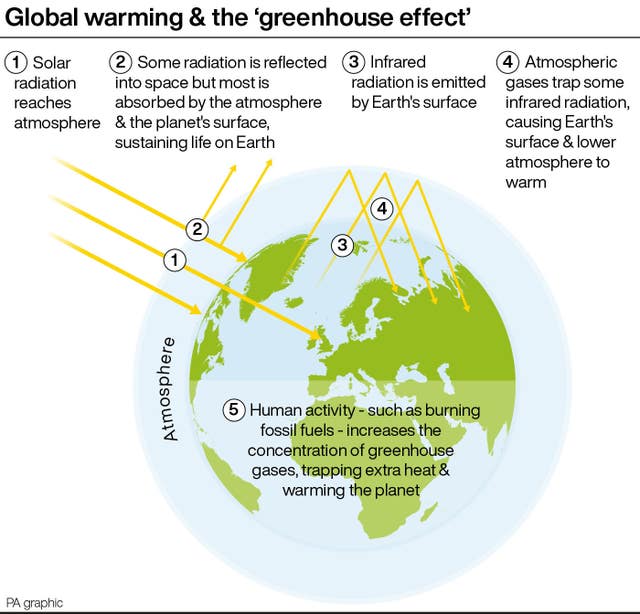
Germany is hosting this year’s meeting of G7 leaders in the Bavarian resort of Elmau, and it wants to keep the focus on the environment.
Before the invasion of Ukraine by Russia triggered a cascade of crises over food, energy and international security, the meeting was meant to put the spotlight on climate change.
The German government under Chancellor Olaf Scholz still plans to get the G7 to commit to collective progress on curbing global warming, and one of the ideas being discussed is the creation of a “climate club” for countries that want to speed ahead when it comes to tackling the issue.
Here, we examine how that could work.

What is a climate club?
The idea was first floated by Nobel Prize winner William Nordhaus, who said the voluntary nature of existing climate agreements has not resulted in sufficient progress.
He proposed that countries serious about reducing emissions could come together and form a club which would jointly set ambitious targets and exempt each other from climate-related trade tariffs that non-members would be subject to.
“This would basically act as a stick as well as a carrot,” said Domien Vangenechten, a policy adviser at the Brussels-based environmental think tank E3G.
Who might join?
Mr Scholz hopes to get the whole G7 behind the idea. France and Italy are virtually given, since both countries are also members of the European Union that is itself a club with strong climate targets.

Canada is keen to finalise a long-discussed trade agreement with the EU and membership of the climate club could help.
Britain left the EU in 2020 and is sceptical about joining any arrangement with the bloc. But a club that includes members beyond the EU would likely be acceptable to London, especially if the United States is in.
Washington has always had a problem entering into binding agreements on climate change, particularly due to Republican opposition. President George W Bush withdrew America’s signature under the 1997 Kyoto treaty and President Donald Trump pulled the US out of the 2015 Paris accord – a much less stringent pact.
The US rejoined Paris under President Joe Biden, however, and there is growing realisation that a go-it-alone approach may not be in America’s interest, especially if it wants to force China to pull its weight on reducing emissions.
Japan may also be swayed by the prospect of putting pressure on its big neighbour and privileged access to European and North American markets.
What about China?
The world’s biggest emitter of greenhouse gas is not likely to join straight away. But if it wants to export its wares to the rest of the world without having climate tariffs slapped on them, it may have to join.

Expect Beijing to be sharply critical of the idea, just as it has been of the EU’s planned “carbon border adjustment mechanism” – which also entails tariffs for polluters who do not play by the bloc’s rules.
China has tried to rally other emerging economies such as South Africa and Indonesia in opposition to the plan. That is one reason why Mr Scholz has invited both of those countries to attend the G7 as guests, and made clear that the climate club is open to all.
Will the idea take off?
Experts say a critical mass of countries will need to join the club for it to become attractive enough that others feel compelled to apply too.
The exact details of how the club’s rules would work are still sketchy. General support by the G7, without any formal commitments, could help put the idea on the agenda at upcoming meetings, particularly the UN climate summit in November.
An endorsement there would show the club is not the exclusive preserve of rich nations but a genuine addition to existing climate efforts.

Will it save the planet?
Johan Rockstrom, director of the Potsdam Institute for Climate Impact Research, thinks it is worth a try given that existing measures are not delivering the emissions cuts required to meet the Paris accord’s target for limiting global warming.
“The world’s remaining carbon budget is running out so fast that we will soon have no scientific chance of keeping to the 1.5C (warming target),” he said.
“So we in the scientific community are grasping at anything that might help, and one way is to get all major emitters to agree on a set of collective principles for emissions pathways and carbon pricing.”
Mr Rockstrom said the hope is that such efforts will eventually reach a positive tipping point, as happened with the 1987 Montreal Protocol that saw the world come together to tackle the ozone problem.
The underlying principle of a climate club would turn upside-down the current situation where the least-ambitious countries set the pace, and instead make it a race to be the fastest, he said.


Comments: Our rules
We want our comments to be a lively and valuable part of our community - a place where readers can debate and engage with the most important local issues. The ability to comment on our stories is a privilege, not a right, however, and that privilege may be withdrawn if it is abused or misused.
Please report any comments that break our rules.
Read the rules hereLast Updated:
Report this comment Cancel